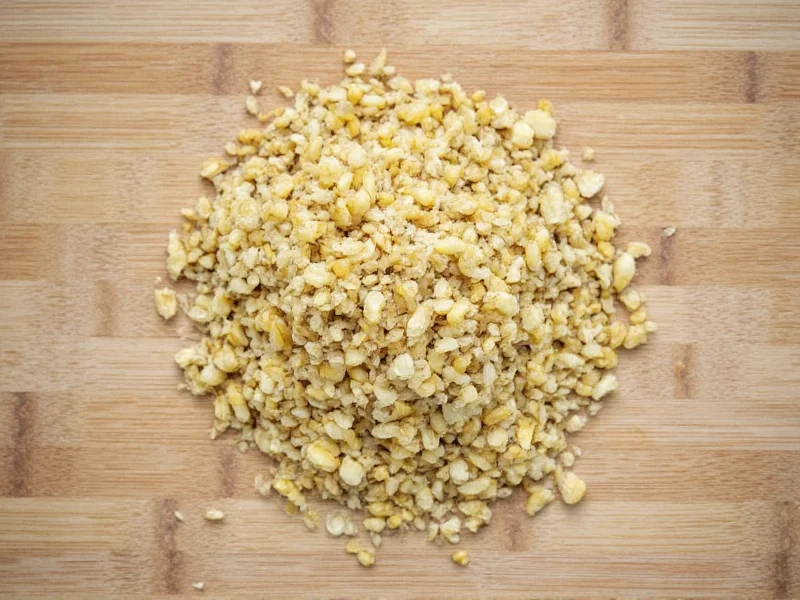Granulated garlic is a dehydrated form of garlic that falls between garlic powder and minced garlic in texture—with coarse, sand-like颗粒 that dissolves more slowly than powder but integrates better than fresh garlic pieces. Unlike garlic powder (which is finely ground), granulated garlic maintains small, visible particles that provide moderate garlic flavor with less intense heat.
Understanding what granulated garlic is begins with recognizing its unique position in the spectrum of processed garlic products. This versatile seasoning offers home cooks and professional chefs a convenient way to add consistent garlic flavor to dishes without the preparation time of fresh cloves. The production process involves dehydrating fresh garlic and then grinding it to a specific consistency—coarser than powder but finer than minced garlic.
How Granulated Garlic Is Made
Manufacturers create granulated garlic through a precise dehydration process. Fresh garlic cloves undergo thorough cleaning, peeling, and slicing before entering industrial dehydrators. The temperature-controlled drying preserves flavor compounds while removing moisture. After dehydration, the garlic passes through specialized mills that produce uniform granules approximately 0.5-1.0 millimeters in size—distinctly larger than the near-dust consistency of garlic powder.
Granulated Garlic vs. Other Garlic Forms
The garlic product landscape features several processed options, each with distinct characteristics:
| Garlic Form | Texture | Dissolution Time | Flavor Intensity | Best Uses |
|---|---|---|---|---|
| Granulated Garlic | Coarse sand-like particles | Moderate (5-10 minutes) | Moderate | Dry rubs, soups, sauces, marinades |
| Garlic Powder | Fine powder | Fast (1-3 minutes) | Strongest | Seasoning blends, baking, quick sauces |
| Fresh Garlic | Whole cloves or minced | Varies by preparation | Freshest, most complex | Sautés, roasts, raw applications |
| Minced Garlic (Jarred) | Small chopped pieces | Moderate | Milder than fresh | Quick sauces, dressings |
Practical Culinary Applications
Professional chefs value granulated garlic for specific cooking scenarios where garlic powder would dissolve too quickly or fresh garlic might burn. Its intermediate dissolution rate makes it ideal for:
- Dry spice rubs for meats that require even distribution without clumping
- Long-simmering sauces where gradual flavor release enhances complexity
- Breadings and coatings that benefit from visible garlic specks
- Commercial food production where consistent flavor distribution matters
Substitution Guidelines for Home Cooks
When adapting recipes, understanding granulated garlic substitution ratios prevents flavor imbalances. The coarser texture means it delivers less concentrated flavor than powder:
- 1 teaspoon granulated garlic = 1½ teaspoons garlic powder (use less powder to avoid overpowering)
- 1 teaspoon granulated garlic = 2-3 fresh garlic cloves (minced)
- 1 teaspoon granulated garlic = 1 tablespoon jarred minced garlic
For best results in what is granulated garlic substitution scenarios, add it early in the cooking process to allow proper rehydration and flavor development.
Storage Recommendations for Maximum Freshness
Proper storage maintains granulated garlic's flavor profile and prevents moisture absorption. Keep it in an airtight container away from heat and light. Under optimal conditions, it retains peak quality for 18-24 months—significantly longer than fresh garlic but slightly less than garlic powder due to its larger particle size. Check for any musty odor or clumping, which indicates moisture exposure and potential flavor degradation.
Nutritional Profile Comparison
While processing affects some nutrient levels, granulated garlic retains many beneficial compounds found in fresh garlic. The dehydration process preserves allicin precursors, though at lower concentrations than fresh cloves. Per tablespoon (6g), granulated garlic typically contains:
- 15 calories
- 0.3g protein
- 3.5g carbohydrates
- Trace amounts of vitamin C and manganese
Unlike fresh garlic, it lacks the enzyme alliinase that creates allicin upon crushing, resulting in different health compound profiles.
Advantages Over Other Garlic Forms
Granulated garlic offers specific benefits that make it worth keeping in your spice collection. Its what is granulated garlic vs powder distinction provides practical advantages:
- Consistent flavor without the variability of fresh garlic heads
- No preparation time compared to peeling and mincing fresh cloves
- Less risk of burning than fresh garlic during high-heat cooking
- Better visual appeal than powder in certain dishes like rubs and coatings
- Longer shelf life than fresh or jarred minced garlic
Common Misconceptions Clarified
Many home cooks mistakenly believe granulated garlic and garlic powder are interchangeable without adjustment. The truth about what's granulated garlic reveals important distinctions. Its larger particle size means it doesn't dissolve as readily as powder, potentially leaving noticeable specks in smooth sauces. Conversely, it integrates more smoothly than jarred minced garlic, which can create uneven flavor pockets. Understanding these differences helps prevent common seasoning mistakes.











 浙公网安备
33010002000092号
浙公网安备
33010002000092号 浙B2-20120091-4
浙B2-20120091-4